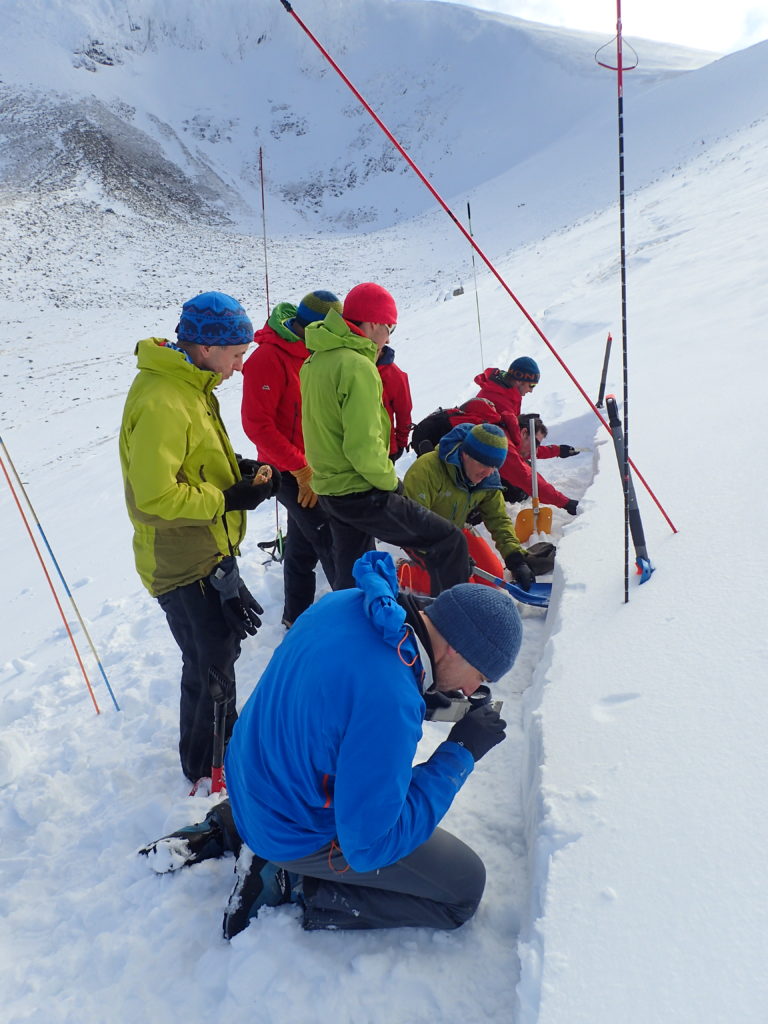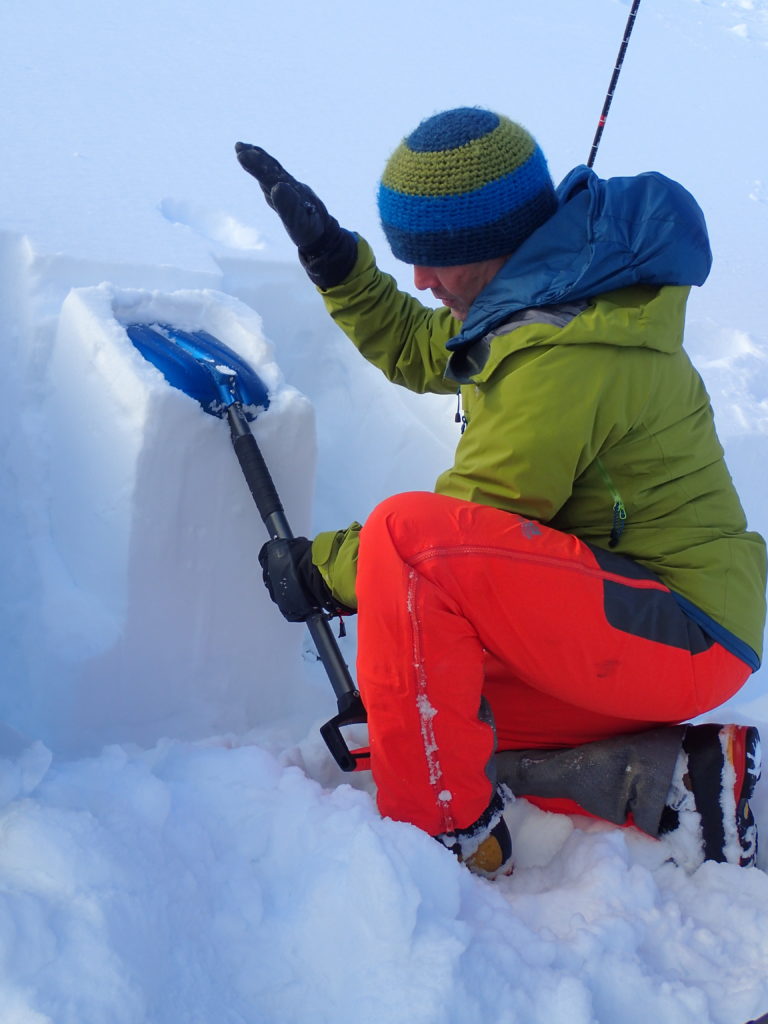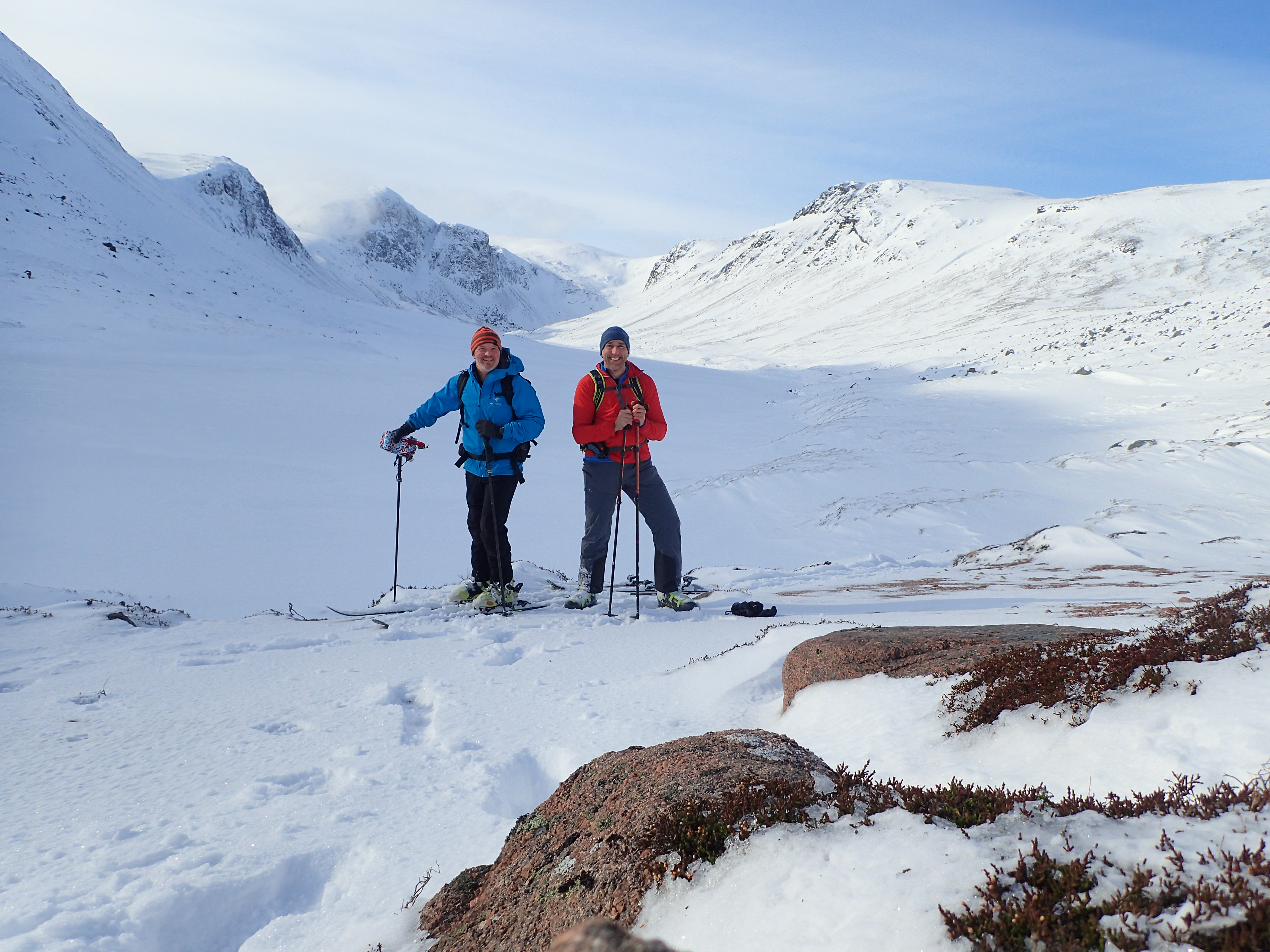Craghoppers ambassador, Al Barnard, details his experience on an Avalanche Awareness course in the far north of Scotland and shares his avalanche safety tips and advice for those who enjoy trekking the highlands, even when the snow hits…
The weather forecaster has got it spot on; the South Westerly wind blows powder crystals down the West ridge of Coire an Lochain in endless snaking waves. The sun hangs in a blue sky with occasional high cloud scudding across the plateau.
The car park is a 45 minute walk away but already we’re in a different world. The Cairngorm plateau is like no other mountainous area in Britain. Carved by glaciers and shaped by the elements, in the teeth of a howling blizzard, this landscape can be brutal.
The avalanche awareness course begins…
Our instructor, Paul Noble, grins and returns to the pristine white slope, continuing to carve out a precise block of snow, exposing and explaining the layers contained within the slice of alpine cake.
Like a tree’s growth rings that tell of an unseen past, the layers of snow that build during winter tell their own frozen story. How much snow has fallen over period, times of thaw and refreeze. Layers of strength, instability and weakness are identified. To a trained eye, the history is crystal clear. More importantly, it helps those in the know to keep track of snowfall and monitor the potential risk of avalanche, making the novices among us to feel a little more comfortable about our presence on Paul’s avalanche awareness training in the Scottish highlands.
Every winter mountaineer knows that snow is more complex than the ubiquitous Christmas card image. Journeying across Scotland’s winter hills requires a basic appreciation of the science which manufactures and distributes the white stuff. This knowledge can make the difference between ranging over hard neve, crampons pleasantly squeaking to ploughing through dangerous wind slab fearful of every foot placement. By learning lessons, taking everything on board throughout our avalanche awareness training, and playing by the rules, Scottish winter mountaineering can be a sublime experience.
I’m at Glenmore Lodge on an Avalanche Awareness Course funded by the Chris Walker Trust.
All participants are Winter Mountain Leaders who are here to gain new avalanche safety knowledge and squeeze as much information as they can from Paul; our instructor who is a full-time avalanche forecaster for the SAIS (Scottish Avalanche Information Service).
After some classroom work on avalanche awareness and the tell-tale signs of danger (with a presentation of SAIS’s Be Avalanche Aware campaign), Paul explains how a persistent weak layer in the snow pack has formed over the last fortnight. Then it’s time to pull on the boots and get on the hill.
Putting our avalanches safety tips into practice…

Making our way to Coire Lochain we note and comment on the variety of snow conditions we encounter, from ice, neve and powder to wind-slab. Hollows, sheltered from the wind have filled in with wind-blown snow. Scoured ridges are studded with rocks. Here we find “raised foot prints” (these structures are formed by the body weight of a walker compressing the snow; all uncompressed snow blows away leaving only the foot prints).
Assembling our avalanche probes we push them into the snow pack feeling for the layers & the resistance they offer. Excavating a series of pits we identify areas of well bonded snow and layers of weakness. The layers are as we envisaged. We are building up a 3D image in our heads based on our findings plus the historical weather and avalanche data. There are no surprises & we find the weak layer Paul had discussed earlier.
Blocks of snow are isolated and tested for strength using the blade of a shovel – a “tap test”.
Detecting a variety of snow crystals using a magnifying glass, we size them using a forecaster’s grid plate and assess them. Some bond and clump together, others remain separate. After, we back-fill our pits to prevent other mountaineers tumbling in to a 10 metre long trench in poor light!

Considerations & Avalanche Safety Tips

Avalanche Hazard, Weather and Mountain Conditions
• Become familiar with the Scottish Avalanche Information Service website: https://www.sais.gov.uk/ (download the Be Avalanche Aware App). It’s a superb tool that will help your decision-making process.
• Educate yourself. The SAIS site is a MUST.
• Review avalanche forecasts & blogs.
• Use weather https://www.mwis.org.uk/scottish-forecast and avalanche forecasts to assist with route choice.
• Build a picture in your mind’s eye where potential hazards could be.
• Ask advice from local mountaineers, game keepers or ski patrol.
Skills & Experience
• Who are you going with? Think winter experience, fitness & navigation skills.
• If journeying with avalanche probes, transceivers & shovels, when did you last practice using them? Are they serviceable?
• If winter mountaineering is new to you, why not join a club where knowledge can be passed on?
• Considered an avalanche awareness training course? How many climbers buy expensive gear yet won’t spend cash on a course that would enhance knowledge and safety?
• Do you and your party know the immediate actions to take in the event of an avalanche?
The Landscape You Intend to Visit
Slope angle?
Most avalanches occur on slopes over 30 degrees. Practice estimating slope angles.
Aspect of slope?
Will the slope be loaded with wind-blown snow?
Bad Places?
Be wary of “terrain traps”. These offer no quick escape route – gullies/cliff tops/narrow ledges.
Avoid operating: beneath sagging cornices, on unstable slopes or below other parties.
Observe & Act (from the moment we leave the house)
• Did I defrost the car? Is snow falling off trees & roofs? Are roads icy or slushy?
• On the hill – how does the snow feel? Is it dry/wet/sticky/chalky/slabby?
• Do crampons crunch on firm neve or do they “ball-up” with soft snow?
• Does the snow crack & fall away in slabs?
• Has fresh snow been blown off wind-ward slopes? Where’s the snow now?
• Fresh avalanche debris? What else is up there?
• Visibility – Can I see the slope above me?
• Be flexible with your plan – if warning bells are ringing, they’re ringing for a reason.
• Don’t be afraid to stop, re-evaluate & adopt Plan B.
• Continually assess & ask “what ifs”.
• Encourage group discussion.
• Observations should confirm learning through our data research. There should be no major surprises.

Now you’re armed with the avalanche safety tips you need, check out the resources mentioned above and don’t hesitate when it comes to investing in an avalanche awareness course.
And finally, stay safe and have fun.
Interested in our other ambassadors and the kinds of outdoor adventures they revel in? Check out our full list of Craghoppers’ ambassadors from jungle survival experts to wildlife filmmakers.
